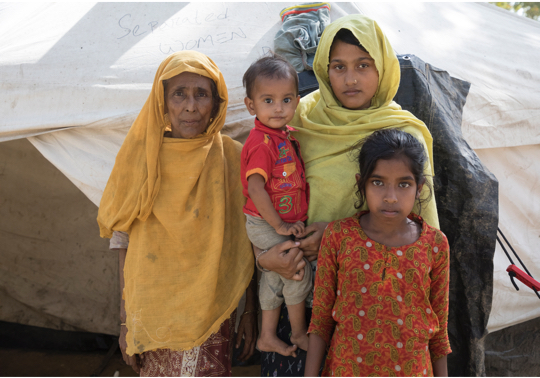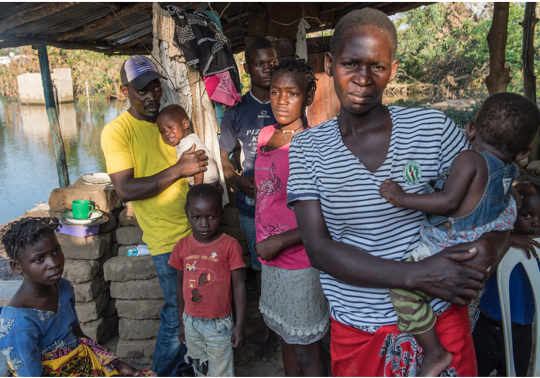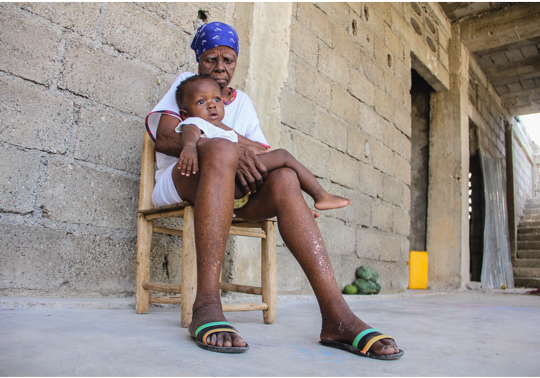Let’s talk about the weather.
Climate change isn't coming soon.
It's already here.
Extreme weather events...
have MORE THAN DOUBLED in just 30 years


could force 122 million more people into hunger and poverty by 2030


are a KEY DRIVER of food insecurity for communities living in poverty


Extreme weather doesn’t affect everyone equally. Over 80% of the world’s hungriest people live in places prone to natural disasters and environmental degradation, meaning CLIMATE STARVES THE MOST VULNERABLE
How are vulnerable populations hit the hardest?
∟ CLICK TO REVEAL

EXTREME
WEATHER
&
EXTREME
IMPACT

Rising temperatures are causing unpredictable, more frequent weather and climate extremes.
EXTREME WEATHER EVENTS SUCH AS:
- droughts
- hurricanes
- flash floods
- desertification
- tropical storms
- heatwaves
- erratic rainfall
LEAD TO EXTREME DEVASTATION IN THE FORM OF:
- food shortages
- contaminated water
- land degradation
- loss of livelihoods
- economic instability
- violence and conflict
- hunger and malnutrition
- displaced families
- gender inequality
- children forced to leave school
- mass migration

Children Forced to Leave School
When crops fail and incomes fall, households facing poverty need all members contributing to the bottom line — which often results in taking children out of school so they can work.

Violence and Conflict
40 percent of civil wars or internal conflicts in unstable countries are the result of competition for scarce food and resources. Extreme weather multiplies the threat of violence.

Displaced Families
Climate extremes like droughts, hurricanes and flooding are becoming more frequent and more severe and are forecasted to displace between 150 million and 1 billion people by the year 2050. When food is scarce, families must leave their homes in search of resources, safety and opportunity.

Gender Inequality
In many places, outdated gender norms lead to women going hungrier when food is scarce. When water is scarce due to droughts or heatwaves, it’s often the women who must walk farther to collect clean water for their families, and young girls leave school to help.

Economic Instability
Impoverished communities lack the resources and assets to rebuild after disaster strikes, making economic instability and hunger quick to follow.
Rising temperatures don't affect everyone, or every place, the same
Take a closer look at how extreme weather is affecting communities around the world & where it's hitting the hardest.
∟ click to continueSub-Saharan Africa
The semi-arid belt of land below the Sahara Desert has experienced the most land degradation of anywhere in the world.
90 percent of Lake Chad has dried up due to rising temperatures, forcing women to walk even further to collect water for their families.
The Lake Chad Basin is now one of the most deprived and dangerous regions in the world, displacing 2.4 million people and leaving over 10 million in need of humanitarian assistance to meet their basic needs. Desertification and erratic rainfall in South Sudan have forced nearly 7 million people into severe hunger.
Learn more about how WFP makes communities more resilient to climate extremes →The Dry Corridor
Extreme drought and erratic rainfall have affected 8 million people in El Salvador, Guatemala, Honduras, and Nicaragua — also known as “The Dry Corridor.”
Drought in South and Central America is causing record high levels of displacement and mass migration.
Learn more about how WFP provides food assistance to more than 700,000 people in the Dry Corridor →Yemen & Syria
In both Yemen and Syria, conflict combines with extreme weather to create severe food insecurity and water scarcity.
Erratic rainfall in Syria has weakened the nation’s agricultural sector, and drought in Yemen has led to reduced harvests. There is little food, if any, leftover to store and sustain families during emergencies.
Learn more about the work WFP is doing to help families survive severe food shortages in Yemen and Syria →Haiti
In 2016, flooding from Hurricane Matthew left more than 800,000 people in need of urgent food assistance.
Intense storms, flooding, landslides and drought continue to massively impede economic growth in Haiti.
Learn how WFP is helping Haitian families survive the devastation and rebuild their lives →Bangladesh
During monsoon season in Bangladesh — between May and August — severe rainstorms, flooding and landslides ruin land and leave families homeless.
Extreme weather events devastate fragile communities like those in Kutupalong, the world’s largest refugee camp.
Learn more about how WFP is working to improve urban readiness for natural disasters in Bangladesh →Zimbabwe
Zimbabwe is in the grips of back-to-back climate disasters, leaving nearly 7 million people – half the population – in the throes of hunger. First, Cyclones Idai and Kenneth struck in 2019 and now the country is hobbled by its worst drought in decades. A plague of locusts is decimating crops in Eastern Africa and migrating closer to Zimbabwe by the day.
The country's corn production – its staple crop – has been cut in half in recent years as a result, and two of the capital's four water reservoirs are empty due to lack of rain.
Learn more about how WFP is scaling up to help families whether the crisis →We're not just talking about the weather. We're doing something to help.
and you can, too.
With your support, the World Food Programme works in communities hit hard by extreme weather to help them recover from and build resilience to climate shocks.







With your help, WFP provides
immediate food assistance
when disaster strikes — doing whatever it takes to help families survive and rebuild.
WFP helps people and communities
withstand extreme weather
events by helping them build community assets like irrigation canals, bridges and hillside terraces.
WFP helps farmers
Reduce Food Loss
with air-tight storage that keeps crops fresh for long periods of time so they can feed themselves and their families through lean seasons and droughts, without the need for humanitarian assistance.
WFP develops
early-warning systems
that detect and forecast extreme weather events, enabling humanitarian agencies and national authorities to anticipate and respond to natural disasters before they strike.
Thanks to
our donors
and a dedicated team of partners, WFP expands microinsurance for farmers in case of crop failure due to unpredictable weather.
WFP Empowers Communities
Resilience programs help communities build their self-reliance and keep families from slipping into chronic hunger and poverty in the wake of extreme weather events.
Sign up to learn about WFP’s efforts and how you can help make a difference.
Sign up now ⟶SEE MORE ⟶